First aid and CPR are essential life-saving skills that empower individuals to act confidently during medical emergencies, saving lives and reducing injury severity.
Importance of First Aid & CPR in Emergency Situations
First aid and CPR are critical in emergency situations, often serving as the difference between life and death. Immediate action can prevent fatalities by maintaining blood circulation and oxygen supply to vital organs. For instance, CPR doubles or triples cardiac arrest survival chances by preserving brain function. First aid addresses injuries like burns, wounds, and fractures, reducing long-term damage. It empowers bystanders to act confidently, mitigating panic and ensuring timely care. Early intervention also stabilizes conditions like choking or allergic reactions, buying time until professional help arrives. Thus, first aid and CPR are indispensable skills, fostering a safer community by enabling rapid, effective responses.
Basic Principles of First Aid
First aid revolves around preserving life, preventing injury worsening, and promoting recovery. Key principles include assessing the situation safely, ensuring personal protection, and providing immediate care. Prioritizing injuries, controlling bleeding, and immobilizing fractures are fundamental. Maintaining airway, breathing, and circulation (ABCs) is crucial, especially in cardiac arrest cases. Cleaning and dressing wounds prevents infection, while cooling burns reduces tissue damage. Psychological support, like reassurance, calms the injured and bystanders. These principles guide effective, timely interventions, bridging the gap until professional medical help arrives. Mastery of these basics empowers individuals to act decisively, saving lives and improving outcomes in emergencies.

First Aid Assessment & Preparation
Assessing the situation, ensuring personal safety, and preparing equipment are critical first steps in providing effective first aid, enabling timely and appropriate care for injured individuals.
Initial Assessment of the Situation
The initial assessment of an emergency situation is crucial for determining the appropriate course of action. It begins with ensuring the safety of both the rescuer and the victim. One should quickly scan the environment to identify potential hazards, such as broken glass, fire, or falling objects. Next, the rescuer should evaluate the condition of the injured person by observing their level of consciousness, breathing, and any visible injuries or bleeding. This step helps prioritize care and decide whether to call for emergency services immediately. A thorough assessment ensures that aid is provided effectively and safely, minimizing further risks.
Ensuring Personal Safety
Ensuring personal safety is the first step in any emergency situation. Rescuers must assess the environment for potential hazards, such as falling objects, fire, or unstable structures, before approaching the victim. Protective gear, including gloves and masks, should be used to prevent exposure to bodily fluids or pathogens. Rescuers should avoid risky actions that could endanger themselves or others. Personal safety is paramount, as an injured rescuer cannot provide effective assistance. Always prioritize securing the scene and using appropriate precautions to minimize risks while delivering care. Remember, safety for the rescuer ensures they can help the victim effectively without compromising their own well-being;
Calling Emergency Services
Calling emergency services is a critical step in any medical emergency. Dial the local emergency number, such as 911 or 112, and stay calm. Provide clear, concise information about the location, nature of the emergency, and the number of people involved. Follow the dispatcher’s instructions carefully, as they may guide you through initial first aid steps. Do not hang up until instructed to do so. Remember, timely communication with emergency services ensures rapid professional assistance, increasing the chances of a positive outcome. Always prioritize calling for help before administering care unless you are trained to do so simultaneously.
Preparing First Aid Equipment
Preparing first aid equipment is essential for effectively responding to emergencies. A well-stocked first aid kit should include bandages, antiseptic wipes, gloves, a CPR mask, and a first aid manual. Regularly inspect the kit to ensure items are not expired or damaged. Additionally, keep a list of emergency contact numbers nearby. Knowing the location of automated external defibrillators (AEDs) in public spaces is crucial, as they are vital for cardiac arrest scenarios. Always maintain a clean and accessible environment for first aid supplies to ensure they are ready for immediate use when needed. Proper preparation saves time and lives during critical moments.
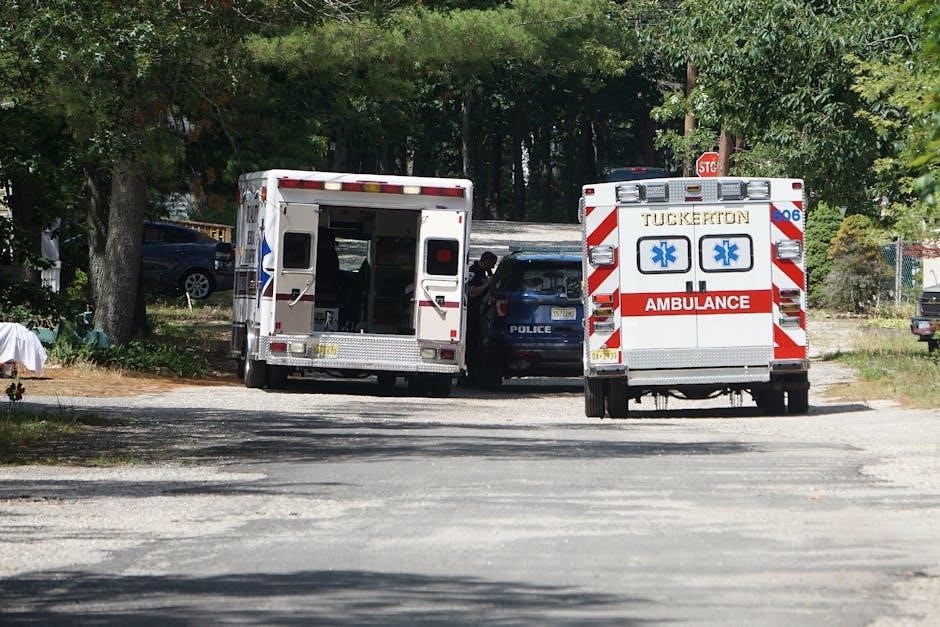
First Aid Techniques
Mastering first aid techniques, such as wound cleaning, bleeding control, and burn treatment, equips individuals to provide immediate care, enhancing recovery and preventing further harm effectively.
Wound Cleaning & Dressing
Proper wound cleaning and dressing are crucial to prevent infection and promote healing. Start by stopping the bleeding with gentle pressure. Rinse the wound with cool or lukewarm water and mild soap to remove dirt and bacteria. Avoid using harsh products like hydrogen peroxide, as they can damage tissue. Pat the area dry with a clean towel. Apply an antibiotic ointment to reduce infection risk and cover the wound with a sterile bandage or dressing. Change the dressing daily or whenever it becomes wet or dirty. This process helps protect the wound, promotes healing, and prevents complications.
Control of Bleeding
Controlling bleeding is critical to prevent shock and promote healing. Apply direct pressure using a clean cloth or bandage to the wound. Elevate the injured limb above heart level to reduce blood flow. If bleeding doesn’t stop, use firm pressure with gauze or a tourniquet. Avoid removing any embedded objects, as this can worsen bleeding. Monitor for signs of shock, such as pale skin or rapid heartbeat, and seek immediate medical attention if bleeding is severe or uncontrollable. Proper bleeding control is essential to stabilize the individual until professional help arrives, ensuring the best chance of recovery and preventing further complications;
Immobilization of Injuries
Immobilization is crucial to prevent further injury and promote healing. Use splints, slings, or rigid materials to stabilize injured limbs or joints. Assess the injury to determine the best immobilization method. Ensure the immobilized area is secure but not overly tight, allowing blood flow. Check for numbness or discoloration, adjusting as needed. Avoid moving the injured area excessively, as this can worsen damage. Immobilization helps reduce pain and swelling while preventing complications like nerve damage. Always seek professional medical attention after immobilizing an injury to ensure proper treatment and recovery. Improper immobilization can lead to long-term mobility issues, so careful technique is essential.
Treatment of Burns
Treating burns promptly reduces damage and promotes healing. For minor burns, cool the area with cool (not ice-cold) water for 10-15 minutes to ease pain and reduce swelling. Avoid using ice directly, as it can cause further tissue damage. Gently remove any clothing or jewelry near the burn without causing friction. Cover the burn with a sterile, non-stick dressing to protect it from infection. For severe burns, do not attempt to remove stuck clothing or break blisters. Keep the burn elevated and seek immediate medical attention. Do not apply home remedies like butter or toothpaste, as these can worsen the injury. Always prioritize professional care for serious burns to ensure proper treatment and prevent complications.
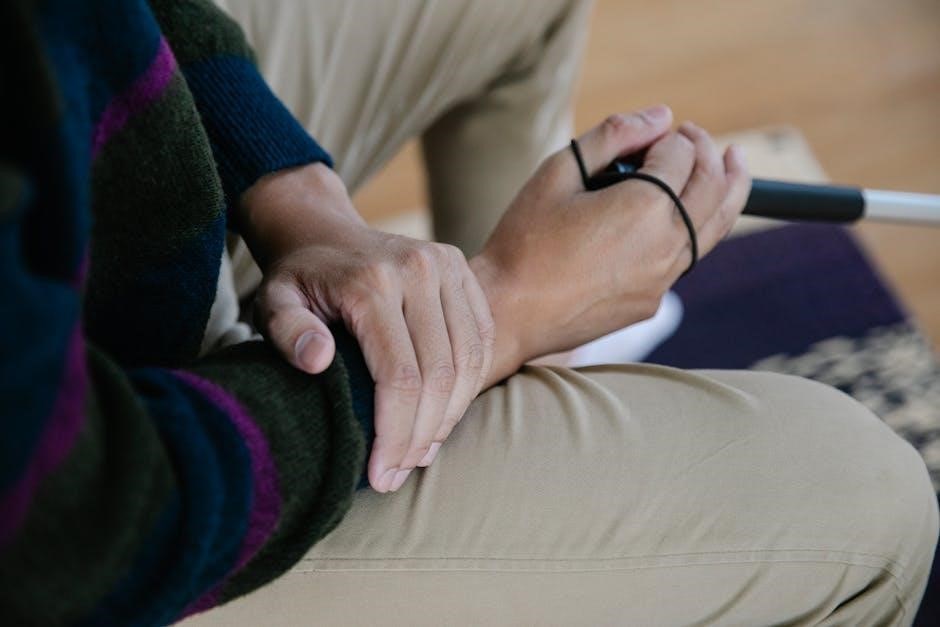
CPR Techniques
CPR involves chest compressions and rescue breaths to maintain blood circulation and oxygen flow during cardiac arrest, crucial for preserving life until medical help arrives.
Adult CPR
Adult CPR involves chest compressions and rescue breaths to restore blood circulation and oxygen flow during cardiac arrest. Call 911 immediately, then start compressions: push hard and fast on the center of the chest at 100-120 beats per minute. If trained, provide two breaths after every 30 compressions. Use an AED if available. Continue until emergency services arrive. Proper technique is crucial; compressions should be 2-3 inches deep. Immediate action doubles or triples survival chances. Untrained bystanders should perform hands-only CPR. Professional training enhances confidence and skill in administering life-saving care effectively.
Child CPR
Child CPR is tailored for children aged 1 to 8 years, combining chest compressions and breaths to maintain blood flow during cardiac arrest. Call emergency services first. Place the heel of one hand on the center of the child’s chest, cover it with the other hand, and interlock fingers. Compress to a depth of about 2 inches at a rate of 100-120 BPM. Provide two breaths after every 30 compressions if trained. For untrained individuals, hands-only CPR is recommended. Immediate intervention significantly improves survival rates and recovery outcomes, making timely and correct action vital in such emergencies.
Infant CPR
Infant CPR is critical for newborns to 12-month-olds, requiring gentle yet effective techniques. Place the infant on a firm, flat surface and call emergency services. Using your thumbs, compress the chest to about 1/4 inch depth at 100-120 BPM. For trained responders, provide two breaths after 30 compressions. Cover the infant’s nose and mouth with your mouth for breaths. If untrained, perform hands-only CPR. Immediate action can significantly improve survival and recovery, emphasizing the importance of proper technique and timely intervention in life-threatening situations.
Hands-Only CPR
Hands-Only CPR is a simplified technique for untrained bystanders to help save lives during cardiac arrest. It involves compressing the chest to a depth of 2-3 inches at a rate of 100-120 compressions per minute. No breathing is required, making it easier for anyone to perform without formal training. This method is endorsed by the American Heart Association and other medical organizations as an effective way to maintain blood circulation until professional help arrives. Continuous compressions improve the chances of survival and recovery by preserving oxygen to vital organs. Hands-Only CPR is a critical skill that can make a significant difference in emergencies.
Chest Compression Rate & Depth
Chest compressions during CPR must be performed at a rate of 100 to 120 compressions per minute and to a depth of 2 to 3 inches in adults. Allow the chest to fully recoil between compressions to ensure effective blood flow. For infants, compressions should be about 1/4 inch deep. Maintaining proper depth and rate is crucial for maximizing cardiac output and increasing survival chances; Consistency and accuracy in compressions help preserve oxygen delivery to vital organs during cardiac arrest. Always follow updated guidelines to ensure life-saving interventions are performed correctly and effectively in emergency situations.
Use of Automated External Defibrillator (AED)
An AED is a portable device that delivers an electric shock to restore heart rhythm during cardiac arrest. Easy to use, it guides users with voice prompts.
When to Use an AED
An AED should be used in cases of sudden cardiac arrest when the victim is unresponsive and not breathing or only gasping. It is crucial to apply the AED before or within the first few minutes of cardiac arrest, as delays significantly reduce survival chances. The device is most effective for ventricular fibrillation or pulseless ventricular tachycardia, which are common causes of cardiac arrest. Always follow the AED’s voice prompts for proper operation and ensure the chest is bare and dry for electrode placement. Do not use an AED if the victim is conscious or has a pulse.
Step-by-Step AED Operation
Using an AED involves a series of clear, straightforward steps. First, turn on the device and follow its voice prompts. Next, ensure the victim’s chest is bare and dry to apply the pads correctly. Attach the electrode pads to the victim’s bare chest as shown on the diagram. Once pads are in place, analyze the heart rhythm by pressing the analyze button or waiting for the device to automatically assess. If a shock is advised, deliver the shock by pressing the shock button. After delivering a shock, immediately begin CPR with 30 chest compressions followed by two breaths. Repeat this cycle until emergency services arrive or the victim regains consciousness. Always follow the AED’s instructions carefully to ensure effective use.
Combining AED with CPR
Combining an Automated External Defibrillator (AED) with CPR is crucial for maximizing survival chances during cardiac arrest. After delivering a shock, immediately begin CPR with 30 chest compressions followed by two breaths. Continue this cycle until emergency medical personnel arrive. The AED and CPR work together to restore a viable heart rhythm, ensuring blood circulation and oxygen delivery to vital organs. This integrated approach significantly improves survival rates when applied promptly and correctly. Always follow the AED’s voice prompts and maintain high-quality CPR to enhance the victim’s chances of recovery.
Choking Relief Techniques
Choking relief techniques involve back slaps and abdominal thrusts to dislodge obstructions. Methods vary for adults, children, and infants to ensure safe and effective intervention.
Adult & Child Choking First Aid
For adults and children, choking relief involves encouraging coughing and using back slaps. If ineffective, abdominal thrusts are performed: stand behind, grasp the abdomen, and thrust inward. For children, the technique is similar but adapted for size. If unconscious, lower onto a firm surface and begin CPR. Call emergency services immediately if choking persists or the person becomes unresponsive. Always prioritize safety and follow proper techniques to avoid causing harm. Proper training is essential for effective intervention and to ensure the best outcomes in choking emergencies.
Infant Choking Relief
For infants under 1 year, choking relief differs from adults and children. If an infant is conscious and choking, sit with the infant face down on your forearm, supported by your lap. Use the heel of your hand to deliver five quick chest thrusts. If the blockage remains, turn the infant over and perform five rescue breaths. If the infant becomes unresponsive, begin CPR with a 30:2 ratio of chest compressions to breaths. Always seek immediate medical attention, even if the blockage is cleared, to ensure the infant’s airway is secure and no complications arise. Proper training is crucial for effective infant choking relief.
Self-Relief Techniques
Learning self-relief techniques for choking is vital for personal safety. If you are choking and unable to cough, speak, or breathe, perform the Heimlich maneuver on yourself. Stand upright and find a sturdy chair or surface at waist height. Place your midsection against the edge, bending slightly forward. Perform quick, firm thrusts inward and upward to dislodge the object. Alternatively, use your fists to apply pressure to your abdomen just above the navel, thrusting inward and upward. Repeat until the blockage is cleared. If unsuccessful, seek immediate medical help. These techniques can save your life until professional assistance arrives.
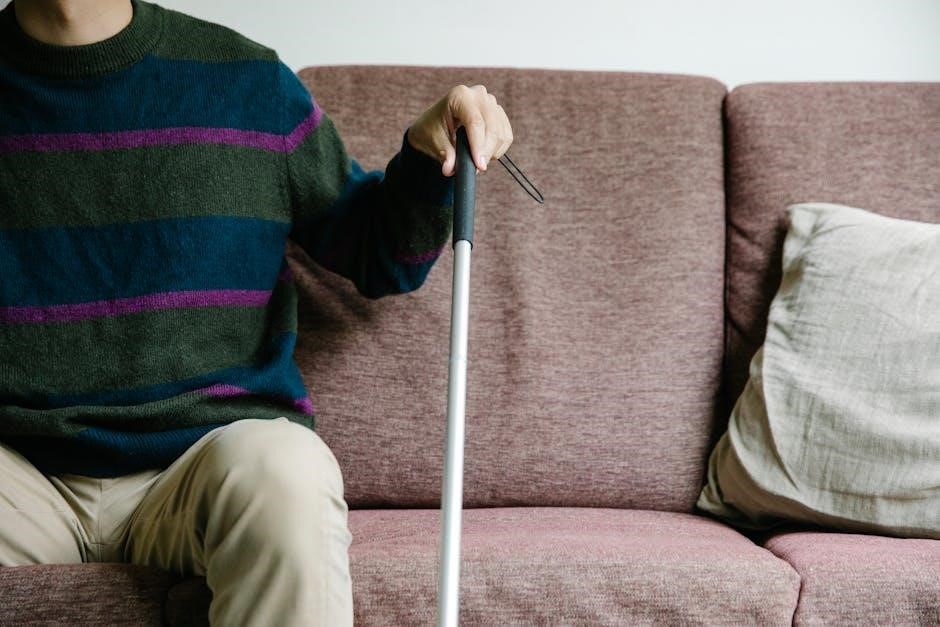
Specialized First Aid Scenarios
Specialized first aid scenarios address critical conditions like cardiac arrest, stroke, seizures, and severe allergic reactions, requiring immediate intervention to prevent fatalities and improve patient outcomes.
Cardiac Arrest Response
Cardiac arrest is a life-threatening emergency requiring immediate action. Upon identifying cardiac arrest, ensure personal safety, call emergency services, and start CPR. Perform chest compressions at 100-120 per minute, allowing chest recoil. Use an AED if available, following its instructions. Continue cycles of 30 compressions and two breaths (if trained). Avoid delays, as early intervention doubles or triples survival chances. Keep the person upright if conscious. Do not leave the person unattended until professional help arrives. Immediate response is critical, as brain damage occurs within minutes without blood flow. Proper technique and adherence to guidelines are essential for effective cardiac arrest response.
Stroke & Seizure First Aid
Recognizing stroke or seizure symptoms is crucial for timely intervention. For a stroke, remember the acronym FAST: Face drooping, Arm weakness, Speech difficulty, and Time to act. If symptoms appear, call emergency services immediately. Do not give medication or food. Keep the person calm and comfortable. For seizures, ensure the area is safe, turn the person onto their side, and cushion their head. Do not restrain or insert objects into the mouth. Note seizure duration and any post-seizure confusion. Provide reassurance and monitor breathing. Do not leave the individual unattended until recovery or medical help arrives. Prompt action improves outcomes for both conditions.
Allergic Reactions & Anaphylaxis
Allergic reactions can range from mild symptoms like hives to severe anaphylaxis, which requires immediate attention. Recognize anaphylaxis by swelling, difficulty breathing, rapid heartbeat, and dizziness. If anaphylaxis occurs, call emergency services promptly. Administer an epinephrine auto-injector if available, following the device’s instructions. Place the person on their back, loosen tight clothing, and stay calm. Do not leave them unattended until medical help arrives. Even if symptoms improve, seek professional care, as reactions can recur. Proper first aid for allergic emergencies can prevent severe outcomes, ensuring the individual receives timely and effective treatment.
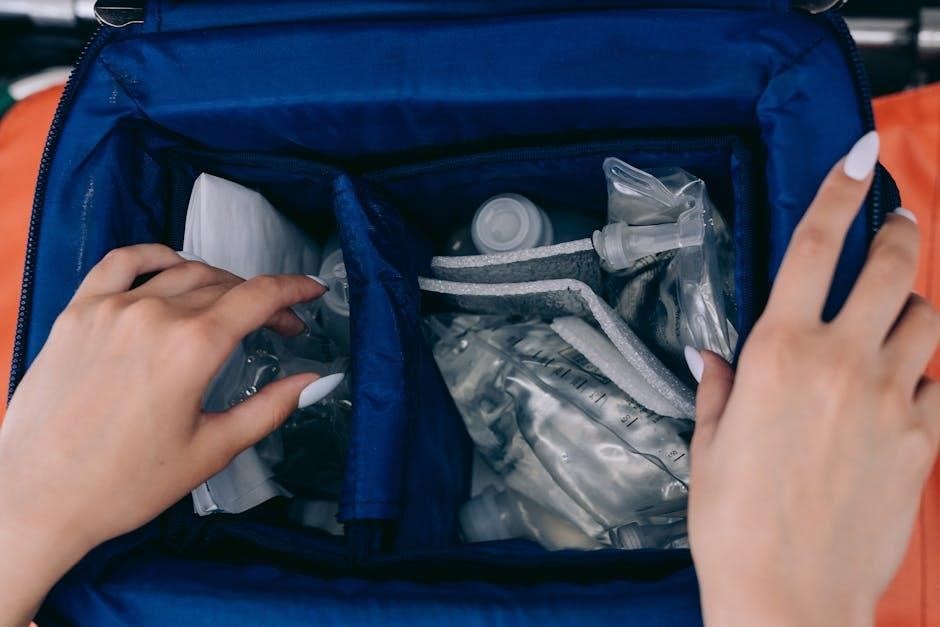
Certification & Training
Certifications in first aid and CPR are offered through various courses, including Standard First Aid & CPR A and C, with options for in-class or online learning.
Available Certification Courses
Various certification courses are available, including Standard First Aid & CPR A and C, offered in 13 to 14 hours in-class or blended with online learning. These courses cover essential skills like wound cleaning, bleeding control, and CPR techniques. The American Red Cross and American Heart Association provide widely recognized certifications, valid for two years. Courses are designed for workplaces, meeting OSHA standards, and are open to all skill levels. Training options include classroom, virtual, and self-paced online learning. Many programs also include AED usage and mental health first aid. Certification requires passing written and practical exams, ensuring competence in emergency response.
Course Duration & Prerequisites
First aid and CPR certification courses typically range from 13 to 14 hours, offered in-class or through blended learning, combining in-person and online sessions. Standard First Aid & CPR A is 13 hours, while Standard First Aid & CPR C is 14 hours. These courses have no prerequisites, making them accessible to all individuals. Completion requires demonstrating proficiency in skills and achieving a minimum of 75% on written exams. Flexible learning options accommodate various schedules, ensuring everyone can gain life-saving skills. Certification remains valid for two years, with renewal options available to maintain up-to-date knowledge and compliance with workplace standards.
Completion Requirements
Successful completion of first aid and CPR courses requires demonstrating proficiency in critical skills and achieving a minimum score of 75% on written knowledge assessments. Participants must perform chest compressions and rescue breaths correctly, operate an AED, and apply first aid techniques effectively. Practical exams evaluate ability to respond to scenarios such as cardiac arrest, choking, and burns. Certification is awarded upon meeting all requirements, valid for two years. Renewal ensures updated knowledge and adherence to current guidelines, maintaining workplace safety and emergency preparedness. These standards ensure trainees are well-equipped to provide effective care in real-life emergencies, enhancing community safety and response capabilities significantly.
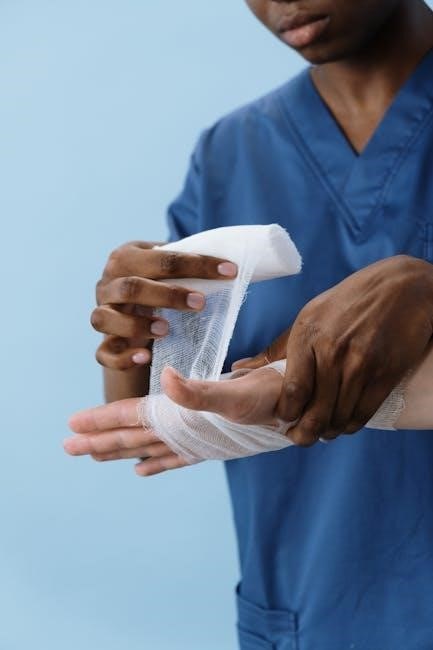
Psychological Aspects of First Aid
First aid includes addressing mental and emotional well-being, helping responders overcome fear and anxiety while providing care, and managing stress post-incident for both victims and responders effectively.
Overcoming Fear of Providing Assistance
Many individuals hesitate to provide first aid due to fear of making mistakes or causing harm. However, proper training and knowledge can significantly reduce anxiety. Understanding the basics of first aid and CPR empowers individuals to act confidently during emergencies. It’s important to remember that the goal of first aid is to stabilize the situation until professional help arrives. Focusing on the victim’s needs rather than personal fears can help responders stay calm. Training programs often include psychological preparation, teaching responders to follow established guidelines and trust their skills. Overcoming fear is crucial, as immediate actions can greatly improve survival rates and outcomes.
Mental Health First Aid Basics
Mental health first aid involves providing support to individuals experiencing emotional or psychological distress. It focuses on listening without judgment, offering reassurance, and connecting them to professional help. Key steps include assessing the situation, ensuring safety, and using non-threatening communication. Training programs teach responders to recognize signs of mental health crises, such as anxiety, depression, or suicidal thoughts. Encouraging open dialogue and maintaining a calm demeanor are essential. Unlike physical first aid, mental health first aid emphasizes emotional support and guidance rather than immediate physical intervention. Early intervention can prevent escalation and promote recovery, making it a vital skill in emergency response.
Stress Management Post-Incident
Managing stress after providing first aid or CPR is crucial for emotional well-being. Techniques like deep breathing, mindfulness, and grounding can help reduce immediate psychological strain. Seeking support from peers, professionals, or support groups is encouraged to process emotions. Reflecting on the incident with a focus on positive actions taken can foster resilience. Prioritizing self-care, including rest and engaging in calming activities, aids recovery. Gradual reintegration into daily routines helps restore balance. Professional counseling is recommended if stress symptoms persist, ensuring long-term mental health. Recognizing the psychological impact of emergencies is key to fostering overall wellness and preparedness for future situations.
Mastering first aid and CPR empowers individuals to act confidently in emergencies, potentially saving lives and reducing injury severity through prompt, proper intervention and care.
Final Thoughts on First Aid & CPR
First aid and CPR are indispensable skills that can significantly improve survival rates and outcomes during emergencies. Prompt action, such as performing chest compressions and using an AED, can double or triple chances of survival.
Regular training and certification ensure individuals are prepared to respond effectively.
Encouraging others to learn these skills fosters a community that values life-saving interventions.
Remember, every second counts, and proper techniques are crucial.
Stay informed and proactive to make a difference in critical moments.
Encouragement for Regular Training
Regular first aid and CPR training is vital for maintaining life-saving skills and staying updated on the latest techniques.
Refreshing knowledge ensures confidence and competence in emergencies.
Many courses offer flexible learning options, including online sessions, making it easier to fit training into a busy schedule.
Organizations like the American Red Cross and Heart Association provide accessible certifications.
Encourage friends, family, and colleagues to join training sessions.
Together, we can create a community prepared to act decisively in critical moments.
Investing time in learning these skills today can save lives tomorrow.